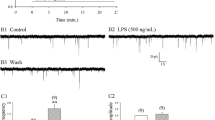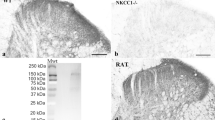Abstract
The metabotropic glutamate receptors (mGluRs) are found throughout the central nervous system, where they modulate neuronal excitability and synaptic transmission. Here we report the presence of phospholipase C-coupled group I mGluRs (mGluR1 and mGluR5) outside the central nervous system on peripheral unmyelinated sensory afferents. Given their localization on predominantly nociceptive afferents, we investigated whether these receptors modulate nociceptive signaling, and found that agonist-induced activation of peripheral group I mGluRs leads to increased sensitivity to noxious heat, a phenomenon termed thermal hyperalgesia. Furthermore, group I mGluR antagonists not only prevent, but also attenuate established formalin-induced pain. Taken together, these results suggest that peripheral mGluRs mediate a component of hyperalgesia and may be therapeutically targeted to prevent and treat inflammatory pain.
This is a preview of subscription content, access via your institution
Access options
Subscribe to this journal
Receive 12 print issues and online access
$209.00 per year
only $17.42 per issue
Buy this article
- Purchase on Springer Link
- Instant access to full article PDF
Prices may be subject to local taxes which are calculated during checkout







Similar content being viewed by others
References
Carlton, S. M., Hargett, G. L. & Coggeshall, R. E. Localization and activation of glutamate receptors in unmyelinated axons of rat glabrous skin. Neurosci. Lett. 197, 25–28 (1995).
Coggeshall, R. E. & Carlton, S. M. Ultrastructural analysis of NMDA, AMPA, and kainate receptors on unmyelinated and myelinated axons in the periphery. J. Comp. Neurol. 391, 78–86 (1998).
Jackson, D. L., Graff, C. B., Richardson, J. D. & Hargreaves, K. M. Glutamate participates in the peripheral modulation of thermal hyperalgesia in rats. Eur. J. Pharmacol. 284, 321–325 (1995).
Zhou, S., Bonasera, L. & Carlton, S. M. Peripheral administration of NMDA, AMPA or KA results in pain behaviors in rats. Neuroreport 7, 895–900 (1996).
Davidson, E. M., Coggeshall, R. E. & Carlton, S. M. Peripheral NMDA and non-NMDA glutamate receptors contribute to nociceptive behaviors in the rat formalin test. Neuroreport 8, 941–946 (1997).
deGroot, J., Zhou, S. & Carlton, S. M. Peripheral glutamate release in the hindpaw following low and high intensity sciatic stimulation. Neuroreport 11, 497–502 (2000).
Omote, K., Kawamata, T., Kawamata, M. & Namiki, A. Formalin-induced release of excitatory amino acids in the skin of the rat hindpaw. Brain Res. 787, 161–164 (1998).
McNearney, T., Speegle, D., Lawand, N., Lisse, J. & Westlund, K. N. Excitatory amino acid profiles of synovial fluid from patients with arthritis. J. Rheumatol. 27, 739–745 (2000).
Conn, P. J. & Pin, J.-P. Pharmacology and functions of metabotropic glutamate receptors. Annu. Rev. Pharmacol. Toxicol. 37, 205–237 (1997).
Neugebauer, V., Lucke, T. & Schaible, H. G. Requirement of metabotropic glutamate receptors for the generation of inflammation-evoked hyperexcitability in rat spinal cord neurons. Eur. J. Neurosci. 6, 1179–1186 (1994).
Neugebauer, V., Chen, P. S. & Willis, W. D. Role of metabotropic glutamate receptor subtype mGluR1 in brief nociception and central sensitization of primate STT cells. J. Neurophysiol. 82, 272–282 (1999).
Fisher, K. & Coderre, T. J. Hyperalgesia and allodynia induced by intrathecal (RS)-dihydroxyphenylglycine in rats. Neuroreport 9, 1169–1172 (1998).
Fisher, K. & Coderre, T. J. Comparison of nociceptive effects produced by intrathecal administration of mGluR agonists. Neuroreport 7, 2743–2747 (1996).
Fisher, K. & Coderre, T. J. The contribution of metabotropic glutamate receptors (mGluRs) to formalin-induced nociception. Pain 68, 255–263 (1996).
Fisher, K., Fundytus, M. E., Cahill, C. M. & Coderre, T. J. Intrathecal administration of the mGluR compound (S)-4CPG, attenuates hyperalgesia and allodynia associated with sciatic nerve constriction injury in rats. Pain 77, 59–66 (1998).
Young, M. R. et al. Behavioural and electrophysiological evidence supporting a role for group I metabotropic glutamate receptors in the mediation of nociceptive inputs to the rat spinal cord. Brain Res. 777, 161–169 (1997).
Vidnyanszky, Z. et al. Cellular and subcellular localization of the mGluR5a metabotropic glutamate receptor in rat spinal cord. Neuroreport 6, 209–213 (1994).
Valerio, A., Paterlini, M., Boifava, M., Memo, M. & Spano, P. Metabotropic glutamate receptor mRNA expression in rat spinal cord. Neuroreport 8, 2695–2699 (1997).
Valerio, A. et al. mGluR5 metabotropic glutamate receptor distribution in rat and human spinal cord: a developmental study. Neurosci. Res. 28, 49–57 (1997).
Jia, H., Rustioni, A. & Valtschanoff, J. G. Metabotropic glutamate receptors in superficial laminae of the rat dorsal horn. J. Comp. Neurol. 410, 627–642 (1999).
Crawford, J. H. et al. Mobilisation of intracellular Ca2+ by mGluR5 metabotropic glutamate receptor activation in neonatal rat cultured dorsal root ganglia neurones. Neuropharmacology 39, 621–630 (2000).
Coggeshall, R. E., Zhou, S. & Carlton, S. M. Opioid receptors on peripheral sensory axons. Brain Res. 764, 126–132 (1997).
Schoepp, D. D., Goldsworthy, J., Johnson, B. G., Salhoff, C. R. & Baker, S. R. 3,5-dihydroxyphenylglycine is a highly selective agonist for phosphoinositide-linked metabotropic glutamate receptors in the rat hippocampus. J. Neurochem. 63, 769–772 (1994).
Gereau, R. W. & Conn, P. J. Role of specific metabotropic glutamate receptor subtypes in regulating hippocampal CA1 pyramidal cell excitability. J. Neurophysiol. 74, 122–129 (1995).
Baker, S. R., Goldsworthy, J., Harden, R. C., Salhoff, C. R. & Schoepp, D. D. Enzymatic resolution and pharmacological activity of the enantiomers of 3,5-dihydroxyphenylglycine, a metabotropic glutamate receptor agonist. Bioorg. Med. Chem. Lett. 5, 223–228 (1995).
Gasparini, F. et al. 2-Methyl-6-(phenylethynyl)-pyridine (MPEP), a potent, selective and systemically active mGlu5 receptor antagonist. Neuropharmacology 38, 1493–1503 (1999).
Litschig, S. et al. CPCCOEt, a noncompetitive metabotropic glutamate receptor 1 antagonist, inhibits receptor signaling without affecting glutamate binding. Mol. Pharmacol. 55, 453–461 (1999).
Annoura, H., Fukunaga, A., Uesugi, M., Tatsuoka, T. & Horikawa, Y. A novel class of antagonists for metabotropic glutamate receptors, 7-(hydroxyimino)cyclopropa[b]chromen-1a-carboxylates. Bioorg. Med. Chem. Lett. 6, 763–766 (1996).
Clark, B. P., Baker, S. R., Goldsworthy, J., Harris, J. R. & Kingston, A. E. (+)-2-methyl-4-carboxyphenylglycine (LY367385) selectively antagonises metabotropic glutamate mGluR1 receptors. Bioorg. Med. Chem. Lett. 7, 2777–2780 (1997).
Contractor, A., Gereau, R. W., Green, T. & Heinemann, S. F. Direct effects of metabotropic glutamate receptor compounds on native and recombinant N-methyl-D-aspartate receptors. Proc. Natl. Acad. Sci USA 95, 8969–8974 (1998).
McCall, W. D., Tanner, K. D. & Levine, J. D. Formalin induces biphasic activity in C-fibers in the rat. Neurosci. Lett. 208, 45–48 (1996).
Puig, S. & Sorkin, L. S. Formalin-evoked activity in identified primary afferent fibers: systemic lidocaine suppresses phase-2 activity. Pain 64, 345–355 (1996).
Taylor, B. K., Peterson, M. A. & Basbaum, A. I. Persistent cardiovascular and behavioral nociceptive responses to subcutaneous formalin require peripheral nerve input. J. Neurosci. 15, 7575–7584 (1995).
Coderre, T. J., Vaccarino, A. L. & Melzack, R. Central nervous system plasticity in the tonic pain response to subcutaneous formalin injection. Brain Res. 535, 155–158 (1990).
Tjolsen, A., Berge, O. G., Hunskaar, S., Rosland, J. H. & Hole, K. The formalin test: an evaluation of the method. Pain 51, 5–17 (1992).
Peng, Y. B., Ringkamp, M., Campbell, J. N. & Meyer, R. A. Electrophysiological assessment of the cutaneous arborization of Adelta-fiber nociceptors. J. Neurophysiol. 82, 1164–1177 (1999).
Carlton, S. M., Zhou, S. & Coggeshall, R. E. Evidence for the interaction of glutamate and NK1 receptors in the periphery. Brain Res. 790, 160–169 (1998).
Lawand, N. B., McNearney, T. & Westlund, K. N. Amino acid release into the knee joint: key role in nociception and inflammation. Pain 86, 69–74 (2000).
Walker, K. et al. mGlu5 receptors and nociceptive function II. mGlu5 receptors functionally expressed on peripheral sensory neurons mediate inflammatory hyperaglesia. Neuropharmacology 40, 10–19 (2001).
Hargreaves, K., Dubner, R., Brown, F., Flores, C. & Joris, J. A new and sensitive method for measuring thermal nociception in cutaneous hyperalgesia. Pain 32, 77–88 (1988)
Abbott, F. V., Franklin, K. B. & Westbrook, R. F. The formalin test: scoring properties of the first and second phases of the pain response in rats. Pain 60, 91–102 (1995).
Carlton, S. M., Chung, K., Ding, Z. & Coggeshall, R. E. Glutamate receptors on postganglionic sympathetic axons. Neuroscience 83, 601–605 (1998).
Acknowledgements
The authors thank L.S. Baggett (Rice University, Department of Statistics) for assistance with the statistical analysis and B. Nadin for cell line immunocytochemistry. This work was supported by grants from the National Institutes of Health (MH60230 to R.W.G. and NS11255 and NS27910 to S.M.C.) and the Spinal Cord Research Foundation (R.W.G.). G.B. is a McNair Scholar of the Baylor College of Medicine Medical Scientist Training Program.
Author information
Authors and Affiliations
Corresponding author
Rights and permissions
About this article
Cite this article
Bhave, G., Karim, F., Carlton, S. et al. Peripheral group I metabotropic glutamate receptors modulate nociception in mice. Nat Neurosci 4, 417–423 (2001). https://doi.org/10.1038/86075
Received:
Accepted:
Issue Date:
DOI: https://doi.org/10.1038/86075
This article is cited by
-
Kinetic fingerprinting of metabotropic glutamate receptors
Communications Biology (2023)
-
New Oral Drugs for Migraine
CNS Drugs (2022)
-
Anatomical organization of the lateral cervical nucleus in Artiodactyls
Veterinary Research Communications (2021)
-
Neurogenic inflammation and its role in migraine
Seminars in Immunopathology (2018)
-
Glutamate and Its Receptors as Therapeutic Targets for Migraine
Neurotherapeutics (2018)



